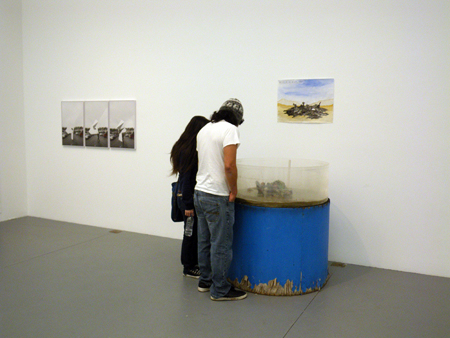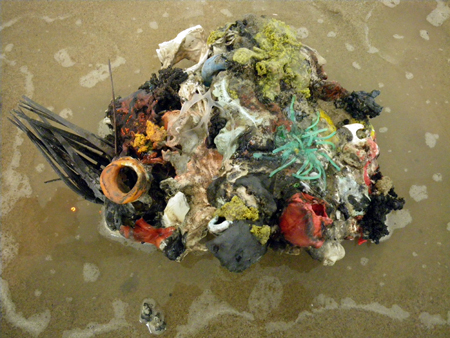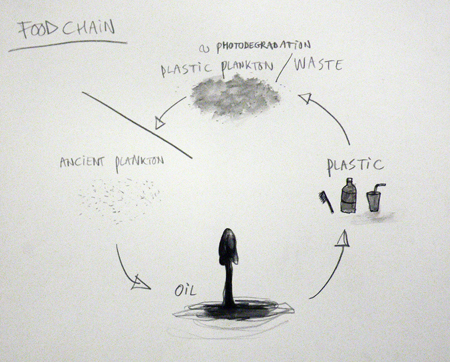THIS IS THE FUTURE BEFORE IT HAPPENED…
Maarten Vanden Eynde
Platic Reef – sample, 2009
THIS IS THE FUTURE BEFORE IT HAPPENED…
(title of exhibition curated by Julie Deamer – Glendale, USA, 02/2009)
A “floating landfill”, twice the size of Texas and made up of plastic particles was swirling about 1,000 miles west of California and 1,000 miles north of the Hawaiian Islands. The trash collected in one area, known as the North Pacific Gyre, due to a clockwise trade wind that circulated along the Pacific Rim. While the plastic trash floated along, instead of biodegrading, it was “photodegrading,” — the sun’s UV rays turned the plastic brittle, much like they would crack the vinyl on a car roof. They broke down the plastic into small pieces and, in some cases, into particles as fine as dust.
Charles Moore, marine researcher at the Algalita Marina Research Foundation in Long Beach who discovered the plastic in 1997 and has been studying and publicizing the patch for the past 20 years, said the debris — which he estimates weighed 3 million tons and covered an area twice the size of Texas —was made up mostly of fine plastic chips and impossible to skim out of the ocean. Also, it was undetectable by overhead satellite photos because 80 percent was plastic and therefore translucent. The plastic moved just beneath the surface, from one inch to depths of 300 feet, according to samples Moore collected .
Ironically, the debris was re-entering the oceans whence it came; the ancient plankton that once floated on Earth’s primordial sea gave rise to the petroleum, being transformed into plastic polymers. That exhumed life, our “civilized plankton,” was, in effect, competing with its natural counterparts, as well as with those life-forms that directly or indirectly fed on them. Inside the North Pacific Gyre the natural plankton was outnumbered 6 to 1 in favor of the plastic plankton. The scale of the phenomenon was astounding. Plastic debris became the most common surface feature of the world’s oceans. What could be done with this new class of products made specifically to defeat natural recycling? How could the dictum “In ecosystems, everything is used” be made to work with plastic ? So far no organism was able to digest plastik plankton or transform it again into something organic, closing back the broken chain of life.
In February 2010 the Belgian artist Maarten Vanden Eynde (1977), based in Rotterdam, The Netherlands, went to the North Atlantic Gyre with a boat to collect 5 tons of plastic debris. He melted it into a huge plastic coral reef and shipped it to Oman. There, in the middle of a dried out sea, located in a dessert called ‘Mother of All Poisons’ (due to the hazardous environmental conditions), he placed the new coral reef as a landart sculpture, a remnant of a forgotten present discovered in a possible future.


